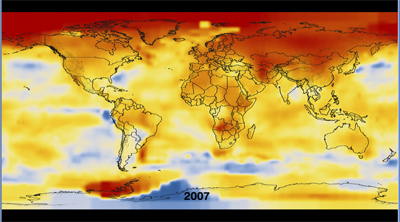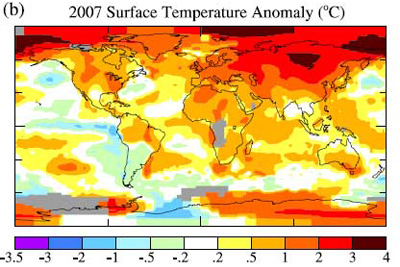Largest body of geologists issues warning on global warming AGU
mongabay.com
January 24, 2008
A statement newly released by the world's largest scientific society of Earth and space scientists--the American Geophysical Union, or AGU--updates the organization's position on climate change: the evidence for it, potential consequences from it, and how to respond to it. The statement is the first revision since 2003 of the climate-change position of the AGU, which has a membership of 50,000 researchers, teachers, and students in 137 countries. The society adopted the statement at a meeting of AGU's leadership body, the AGU Council, in San Francisco, California, on 14 December 2007. AGU position statements expire in four years, unless extended by the Council.
Revised statement from the American Geophysical Union on climate change
The Earth's climate is now clearly out of balance and is warming. Many components of the climate system--including the temperatures of the atmosphere, land and ocean, the extent of sea ice and mountain glaciers, the sea level, the distribution of precipitation, and the length of seasons--are now changing at rates and in patterns that are not natural and are best explained by the increased atmospheric abundances of greenhouse gases and aerosols generated by human activity during the 20th century. Global average surface temperatures increased on average by about 0.6 degrees Celsius over the period 1956-2006. As of 2006, eleven of the previous twelve years were warmer than any others since 1850. The observed rapid retreat of Arctic sea ice is expected to continue and lead to the disappearance of summertime ice within this century. Evidence from most oceans and all continents except Antarctica shows warming attributable to human activities. Recent changes in many physical and biological systems are linked with this regional climate change. A sustained research effort, involving many AGU members and summarized in the 2007 assessments of the Intergovernmental Panel on Climate Change, continues to improve our scientific understanding of the climate.
0 Temperature anomalies that were present during 2007. Credit: NASA
This shows temperature anomalies for the 2007 calendar year relative to the 1951-1980 mean. Warmer areas in red, cooler areas in blue. Largest increases were in the northern hemisphere. Credit: NASA Goddard Institute for Space Studies (GISS)
Scientists: cut emissions now to avoid climate tipping point (December 14, 2007) - Countries need to act soon to cut carbon dioxide emissions if the worst impacts of global warming are to be avoided, warned a panel of scientists speaking Thursday at the fall meeting of the American Geophysical Union in San Francisco. The scientists -- James Hansen, director of NASA's Goddard Institute for Space Studies; Richard Alley, a professor at Pennsylvania State University; Josefino Comiso, a senior researcher at NASA's Goddard Space Flight Center; and Peter Webster, a professor at the Georgia Institute of Technology - said that Earth's climate system is approaching tipping points that once breached may be irreversible and unstoppable on a practical time scale.
During recent millennia of relatively stable climate, civilization became established and populations have grown rapidly. In the next 50 years, even the lower limit of impending climate change--an additional global mean warming of 1 degree Celsius above the last decade--is far beyond the range of climate variability experienced during the past thousand years and poses global problems in planning for and adapting to it. Warming greater than 2 degrees Celsius above 19th century levels is projected to be disruptive, reducing global agricultural productivity, causing widespread loss of biodiversity, and--if sustained over centuries--melting much of the Greenland ice sheet with ensuing rise in sea level of several meters. If this 2 degrees Celsius warming is to be avoided, then our net annual emissions of carbon dioxide must be reduced by more than 50 percent within this century. With such projections, there are many sources of scientific uncertainty, but none are known that could make the impact of climate change inconsequential. Given the uncertainty in climate projections, there can be surprises that may cause more dramatic disruptions than anticipated from the most probable model projections.
With climate change, as with ozone depletion, the human footprint on Earth is apparent. The cause of disruptive climate change, unlike ozone depletion, is tied to energy use and runs through modern society. Solutions will necessarily involve all aspects of society. Mitigation strategies and adaptation responses will call for collaborations across science, technology, industry, and government. Members of the AGU, as part of the scientific community, collectively have special responsibilities: to pursue research needed to understand it; to educate the public on the causes, risks, and hazards; and to communicate clearly and objectively with those who can implement policies to shape future climate.
Read more... Sphere: Related Content











1 comment:
Marc Morano response here: http://dotearth.blogs.nytimes.com/2008/01/24/earth-scientists-express-rising-concern-over-warming/#comment-8596
10.
January 24th,
2008
1:27 pm
From Marc Morano:
Dear New York Times:
I hate to burst the bubble here, but the American Geophysical Union’s (AGU) climate ‘consensus’ statement does not hold up to even the lightest scrutiny.
It appears that the AGU Board issued a statement on climate change without putting it to a vote of the group’s more than 50,000 members. Its sweeping claims were drafted by what appears to be only nine AGU committee members. The statement relies heavily on long term computer model projections, cherry-picking of data and a very one-sided view of recent research. As with the recent statements by the American Meteorological Society (AMS) and the National Academy of Sciences (NAS), the AGU statement is the product of a small circle of scientists (again apparently a 9 member panel according to AGU) who all share the same point of view, and who failed to put their statement to a vote of the AGU members on whose behalf they now claim to speak. As such it amounts to nothing more than a restatement of the opinion of this small group, not a ‘consensus’ document.
Bottom line, this new AGU statement appears to in no way represent the views of the AGU rank-and-file members. As previously stated, we know both AMS and NAS had only two dozen or so board members vote on their ‘consensus’ statement. And the Canadian Academy of Sciences reportedly endorsed a “consensus” global warming statement that was never even approved by its governing board. consensus’
Further, the media hyped UN IPCC Summary for Policymakers in 2007 only had 52 scientists participate!
For more on debunking so-called ‘See: http://epw.senate.gov/public/index.cfm?FuseAction=Minor ity.Blogs&ContentRecord_id=595F6F41-802A-23AD-4BC4-B364 B623ADA3
We must be honest about now these ‘consensus’ statements are produced. The only way rank-and-file AGU members can weigh in is to make comments to the panel. This is not ‘consensus.’
To read the voices of scientists from around the world, please check out the U.S. Senate report detailing over 400 scientists who recently dissented from man-made global warming fears. (Note: 400 plus scientists are more than 8 times the number of scientists who participated in IPCC Summary For Policymakers)
http://epw.senate.gov/public/index.cfm?FuseAction=Minor ity.SenateReport
Sincerely,
Marc Morano
U.S. Senate Environment & Public Works Committee
— Posted by Marc Morano
Post a Comment